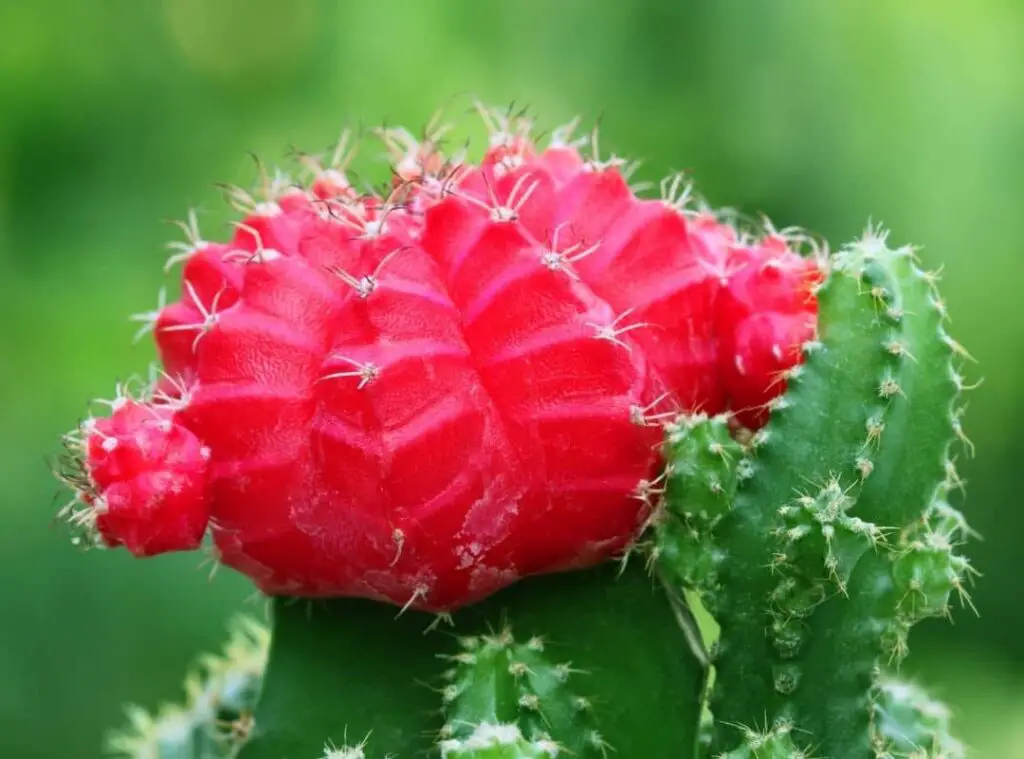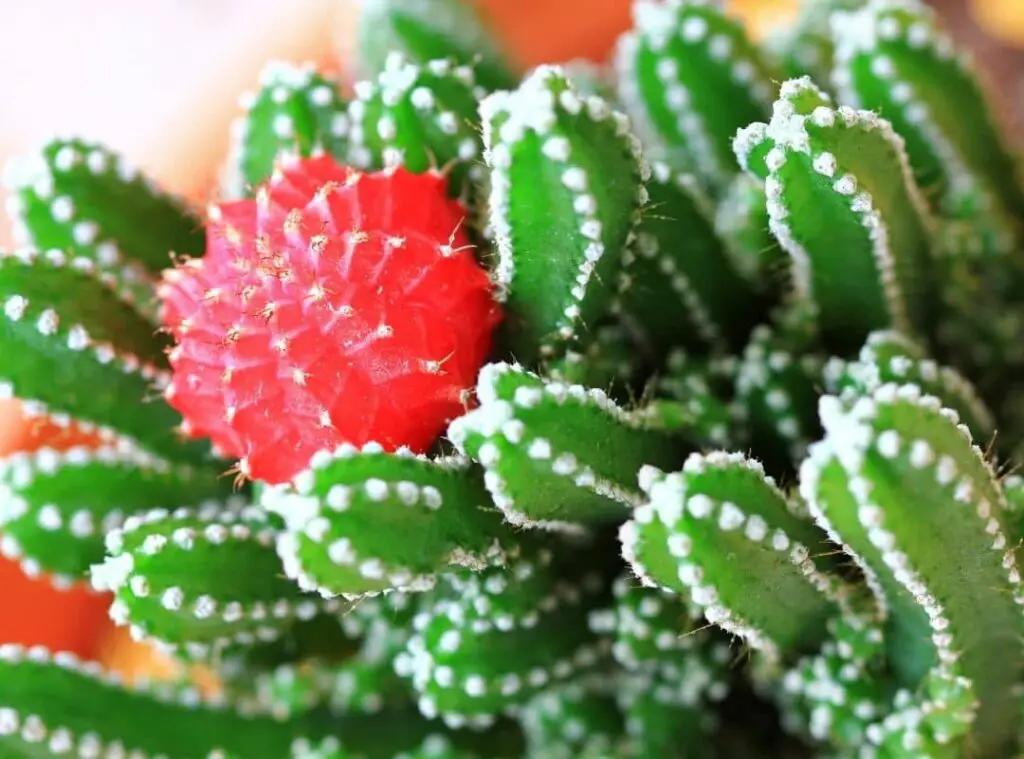I have a question for you. Have you ever seen a moon cactus in the wild? your answer might be yes. But read this article and think about it again.

Is moon cactus in the wild?
It is a simple question with a complicated answer. The moon cactus plant is not a single species. It is a combination of two plants.
The colorful upper part is known as Gymnocalycium mihanovichii and it is often found in desert areas of South America, Argentina, Bolivia, Brazil and Paraguay.
There are about over 80 species of Gymnocalycium Mihanovichii in the world.
The lower part of the moon cactus plants belong to the genus Hylocereus. So as the colorful mutants of Gymnocalycium mihanovichii do not have enough chlorophyll on them to survive on their own, they need help.
One day one brilliant person tries to draft Gymnocalycium Mihanovichii into Hylocereus in order to survive the colorful plant.
He or she was successful in that process and thanks to that person we today have beautiful and unique moon cactus with us.
Now you can understand the complexity of the answer. Actually you can not see the whole moon cactus plant in the wild environment.
But at the same time you can see part of it in the wild habitats of Argentina and Paraguay.
When they grow in the wild, they usually tend to grow under the shade of other vegetation. As such they would love to have bright and indirect sunlight and not direct sunlight.
Where do Moon Cactus come from?
As aforesaid, moon cactus is hailing from South America. You could mainly spot them in desert areas of Argentina, Paraguay, Brazil and in Bolivia too.
Further moon cactus is a set of plants which run short of chlorophyll. Chlorophyll is important for energy production through photosynthesis.

How do moon cacti grow in the wild?
Moon cactus usually tend to grow in areas where they can get shade. They would ideally look for places where they can get bright indirect sunlight.
Lifespan of the moon cactus in the wild.
When it comes to the lifespan of the moon cactus in the wild, it could be one to three years.
Having said that, when it comes to indoor grown moon cactus life spans, you could find some anecdotes of succulent keepers who could keep the moon cactus specimens for a longer period than that.
Chances are that they could keep them for more than five years.
Besides that, there could also be circumstances where moon cactus could live for a few months too.
That could be quite common to see if you do not provide the proper growing conditions for them, particularly if you are an experienced gardener.
Can moon cactus grow without grafting?
Colorful variant or the mutant variant of the Gymnocalycium Mihanovichii can not survive in the wild without grafting. But normally Gymnocalycium Mihanovichii can survive on their own.
Are moon cactus man made?
Moon cactus are man made plants. It is a combination of mutat variant of Gymnocalycium mihanovichii and the Hylocereus plant.
You can see, many garden shops sell this plant worldwide. On another note, most of these moon cacti do not produce chlorophyll and they are all mutant varieties.
As such the rest of the pigments could be seen in green. Those mutants would perish due to lack of chlorophyll as seedlings.
Consider that you got one of these mutants and wish to make them stay alive. Then, you could consider grafting them to other species of cacti and that will help them to thrive well.
What is more interesting about this plant is that the bottom part of the cactus could be some other genus as it is not necessary that it should be in the same genus.
One of the most common species of plants which is used for the grafting process of moon cactus is dragon fruit.
Can you plant moon cactus babies?
To answer the question, yes you could plant the moon cactus babies. You would see how the moon cactus starts to produce those little bumps.
You could spot them as colored balls and they usually look like the mini versions of the plant on the side look.
Some people may misunderstand that as flowers. In fact, they are babies, or you could even call them pups.
You could use those moon cactus pups for propagation. However, keep in mind that you could use them only if they are green or darker color only.
If not, it is not possible for them to thrive without grafted to a host cactus. You could just let them grow where they are, or you may even get rid of them if you do not wish to have them.
If you wish to graft them, typical stock cactus such as Hylocerus undatus or Myrtillocactus geometrizans would be handy.
You could simply take a slice off from the stock cactus top part first. After that, you could obtain a slice from the moon cactus baby towards the bottom part of it.
Next, simply keep them enclosed whilst ensuring that sliced areas are touching and they are staying tied together.
You could leave it like that for about a week. So that they will have enough time to bind.
On the other hand, if you own a moon cactus pup, which is a dark colored variety or a burgundy or dark purple variety, you do not need to graft them with a host cactus as they could thrive well on their own.
You could simply take the pup off and place it on top of the cactus soil. As the time passes, they will start to form roots.

Related questions
Why is it called a moon cactus?
The exact reason for calling them moon cactus is not clear yet. But when you think about their shape, the upper part looks like a ball or moon.
But the exact reason for the name is yet to be discovered.
Does moon cactus need sunlight?
Moon cactus would require bright and indirect sunlight. Do not expose them for full sunlight as it could badly affect the plant.
Therefore, keep the plant away from direct full sunlight as much as you can.
Can moon cactus grow big?
Moon cactus would rise to 12 inches (30.5 cm). In terms of the width, it would also be a few inches. They are small and spherical cacti.
Read Next: Moon Cactus Meaning | 5 Things You Should Understand |
Read Next: Moon Cactus Flowers | 6 Colorful Facts For Moon Cactus Lovers |
Read Next: Moon Cactus Colors | 8 Color-related Facts You Must Know |
